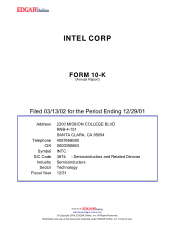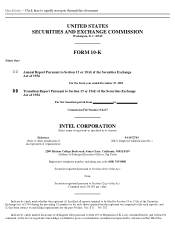Intel 2001 Annual Report Download - page 7
Download and view the complete annual report
Please find page 7 of the 2001 Intel annual report below. You can navigate through the pages in the report by either clicking on the pages listed below, or by using the keyword search tool below to find specific information within the annual report.
developers and solutions providers to make it easier for end users to
5
deploy best-of-class e-Business solutions on Intel architecture. Products include Intel® C/C++ and Fortran compilers, VTune™ Performance
Analyzer and Intel® Performance Libraries that take full advantage of the latest performance and capabilities of our microprocessors. As part
of our Early Access Program, developers have worldwide access to our online technical references with Intel® Developer Services. This
program's services include technical consultants in data centers worldwide providing application porting, tuning, optimization, scaling,
benchmarking and integration of software solutions.
Sales and gross margin. During 2001, sales of microprocessors based on the P6 microarchitecture and related board-level products and
chipsets comprised a majority of our consolidated net revenues and a substantial majority of our gross margin. For the same period, sales of
products based on the Intel NetBurst microarchitecture and related products were a significant and rapidly increasing portion of our
consolidated net revenues and gross margin. For 2000 and 1999, sales of microprocessors based on the P6 microarchitecture and related
products comprised a substantial majority of our consolidated net revenues and gross margin.
Intel Communications Group
The Intel Communications Group provides products for the networking and communications platform based on three focus areas that we
believe to be defining trends for the Internet: Ethernet connectivity products, optical components and network processing components that
provide programmable building blocks for modular networking infrastructure. We also offer embedded control chips for use in laser printers,
imaging products, automotive systems and other applications.
We provide products to telecommunications and networking OEMs, Internet service carriers and providers and makers of a wide range of
industrial and communications equipment who have seen a significant impact from the worldwide economic slowdown. In particular, we
continue to be affected by the ongoing slump in the telecommunications industry. These market conditions impact our ability to successfully
execute our strategies, as we are dependent in part on the capital expenditure levels of carriers and service providers, as well as on component
purchases by our OEM customers, growth in the demand for Internet infrastructure, and acceptance of our network architecture. In addition, the
success of our strategies will be affected by our ability to integrate recent acquisitions and get new products to market in a timely manner.
Net revenues for the Intel Communications Group operating segment comprised approximately 10% of our consolidated net revenues for
2001.
Ethernet connectivity products. Ethernet is an industry-standard technology used to translate and transmit data in packets across
networks. As Ethernet expands from the traditional local area network (LAN) environment into the wireless LAN market segment, the
metropolitan area network (MAN) and the networked storage market segment, we are expanding our Ethernet product portfolio to address these
emerging market segments. In storage, we are developing products that enable storage resources to be added to any location on an Ethernet
network. For the MAN market segment, we offer Ethernet products at multiple levels of integration to provide a low cost solution with
increased speed and signal transmission distance (commonly referred to as "reach").
In 2001, we introduced the world's first single-chip Gigabit Ethernet controller, which runs up to 10 times faster than the previous
industry-standard Fast Ethernet product. Gigabit Ethernet networks allow the transmission of 1 billion individual bits of information per
second. By contrast, standard Ethernet networks transmit 10 or 100 million bits of information per second (Mbps, or megabits per second). The
Intel® 82544EI Gigabit Ethernet Controller is more than 50% smaller than previous generations of controllers, uses 50% less power and
generates less heat. Competing Gigabit Ethernet products require a complex board-level design to accommodate the multiple chips needed to
carry out the same functions as Intel's single-chip solution. In 2001, we also introduced the Intel® 82544GC
6
Gigabit Ethernet Controller, in a reduced-size package aimed at ultra-dense or space-constrained servers.
Other products for Gigabit Ethernet applications introduced in 2001 include the 16-port Intel® Media Switch IXE5416 Gigabit Device
designed to help build faster plug-and-play Ethernet switches; the Intel® PRO/1000 T Desktop Adapter and Intel® PRO/1000 XT Server
Adapter, designed to help IT managers upgrade existing Ethernet (10 Mbps) or Fast Ethernet (100 Mbps) networks; and the Intel® PRO/1000
T IP Storage Adapter, designed to connect storage devices located anywhere on an Ethernet network.
In February 2002, we announced the introduction of high-performance, low-power processors for networking and storage equipment
based on Intel® XScale™ technology and highly integrated gigabit Ethernet controllers. We also announced three new single-chip Gigabit
Ethernet products for desktop PCs, workstations and servers that are up to 45% smaller and use less power than previous products. The




















